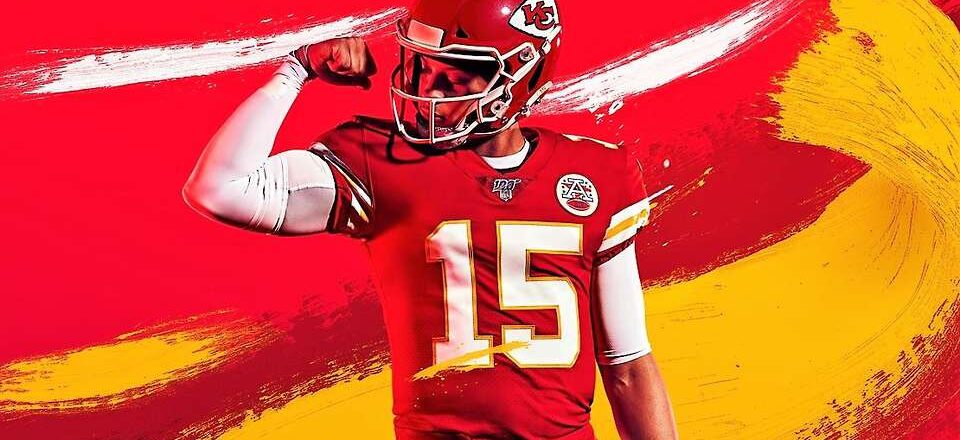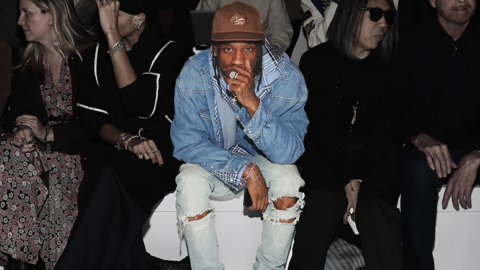What the Mahomes Contract Really Means
It has been celebrated, panned, and dissected in a million different ways. What is the truth behind Patrick Mahomes’s historic contract? With insights from the deal’s architects, interviews with two quarterbacks who signed similarly mind-blowing agreements, and a look across the sports landscape, we tried to find out.
The Contract just sat there, on a table at Andy Reid’s house, near platters offering cold cuts, hummus dip and vegetable medleys. A bucket of Dom chilled on ice, next to the banner standing close by, the one emblazoned with Chiefs logos to properly announce The Contract to the world. In heft, The Contract resembled an old phone book, clocking in at more than 100 pages. And, as signing hour approached on an early-July afternoon, everyone in the inner circle of Patrick Mahomes looked both backward and forward, hoping to contain news of the historic extension for another few hours.
Then, as lawyers for the NFL Players Association scoured the final details in an agreement that had taken 18 months to complete, the story broke like a dam overwhelmed—and from the most unlikely insider, a beer manager/die-hard Chiefs supporter at a downtown Kansas City liquor store. Mahomes and his closest confidants—agents Chris Cabott and Leigh Steinberg; his father, mother, two siblings and girlfriend; plus top members of the Chiefs brass (minus Reid, who could not have any contact with his players)—could only laugh. They knew exactly what would happen next.
The Contract instantly became a historical sports document, its parameters criticized by other agents, praised by Mahomes and celebrated by the beer manager and others throughout Chiefs Kingdom. The Contract could* be worth half a billion dollars and should* tie Mahomes to KC for the rest of his career. And, in a broader sense, The Contract would also be shown to embody both how NFL deals differ from agreements in other sports, and how they rarely deliver exactly as laid out.
Mahomes scribbled his name onto the white pages, making the document legal, securing mind-boggling, generational wealth. The whole group posed for pictures, cracking open the bubbly as general manager Brett Veach toasted to a future of Super Bowl championships like the one they nabbed back in February. Cabott thanked his counterparts from the negotiating table. Social distancing measures were taken because of COVID-19. Someone even saved the pen that Mahomes used as a memento. The only thing missing was one of those giant game-show checks.
Finally, just as they had done after Mahomes agreed to his rookie contract in 2017, the quarterback, his agents and Veach looped signatures onto a Chiefs helmet. Almost three years to the day, exactly. As Cabott would note later, the people in the original pictures and the current ones were also exactly the same.
Patrick Mahomes, budding NFL icon, had made history once again. The headline: 10 years, $503 million, largest deal in the history of sports. The truth, while no less groundbreaking, is quite a bit more complicated.
Representatives for Mahomes first examined the basic parameters for an extension in January 2019. They wanted to lay out for the superstar what they considered the two most important factors in any deal: whether he would reset the quarterback market in a short-term sense or a long-term one, and how either option would work in tandem with the Chiefs’ salary-cap dynamics, both for overall philosophy and available cash.
In terms of fit, the answer could not have been simpler. Mahomes loved the small-town feel of Kansas City, how he could dine out uninhibited; he loved his owners, the Hunt family; his boss (Reid), his offensive coordinator (Eric Bieniemy) and his position coach (Mike Kafka). Steinberg’s relationship with the franchise dates all the way back to 1977, and he has represented some Kansas City legends, from the late Derrick Thomas to Christian Okoye to Tony Gonzalez to one Patrick Mahomes.
As the Super Bowl season unfolded, the quarterback’s reps continued to drill deeper on short- versus long-term options. A three- or four-year guaranteed deal held great appeal and fit with recent trends throughout sports. Foremost, it would allow the agents to renegotiate again while Mahomes remained in his prime and the salary cap continued to rise like an elevator that would never stop. But Cabott saw one prominent hang-up with a shorter agreement: Unlike in baseball and basketball, when an NFL star signs a deal, the team must immediately fund all of the guaranteed cash to the NFL, and he believed it would be more difficult to maximize the money for that reason. The agents looked into taking out an insurance policy to offset the unlikely but not impossible event that Mahomes wouldn’t be able to negotiate for a third time (like, if for any reason, he never played again). But none of the policies, combined with a shorter, all-guaranteed contract could net as much total as the longer-term options.
Steinberg had long sought out contract innovations. He helped Steve Young push cash to later years in one deal while accurately predicting that then President Ronald Reagan would drop tax rates. He helped create the concept of “voidable” years so that top players could reach free agency earlier if they hit basic incentives.
Now, Team Mahomes sought to find a permissible route around that cash-up-front rule. They settled on a clunky term: guarantee mechanisms. Both Cabott and Steinberg describe it as the latest innovation in the evolution of pro football contracts. The first five years—and roughly $140 million—of Mahomes’s deal are guaranteed against injury. But for each year that he remains on the Chiefs’ roster, significant, eight-figure chunks—at least $21.7 million (’21) and as much as $49.4 million (’27)—become guaranteed. There are buyout opportunities, but those very guarantees make releasing Mahomes in any one season prohibitively expensive, which to his reps means that Mahomes basically signed a guaranteed contract, without the Chiefs needing to lay out over $400 million up front. In the improbable event he is let go, he would then hit the open market.
Mahomes did not take the same route as Kirk Cousins, who played out two franchise-tag seasons with the football team in Washington, then signed for three years in Minnesota for $84 million guaranteed, then renegotiated this spring to add two seasons but help the Vikings increase their 2020 cap space. Mahomes chose the opposite path to the same place.
The structure, Cabott says, borrowed from basketball in the guarantee mechanisms and from baseball in the no-trade clause the Chiefs agreed to, making it unlike any agreement in NFL history. Mahomes came to like the longer, more creative option best. “This way,” Cabott says, “he reset the market at the position and for the sport and for all of sports.”
Given the remarkable nature of The Contract, the Mahomes deal includes a game of sorts. Call it Fun With Numbers. It’s like Mad Libs, except instead of “insert adverb” it’s “insert detail that supports your take.” The basics: Mahomes signed a 10-year extension, on top of the two years that remained on his rookie deal. The extension is worth $450 million, plus incentives, and could tether Mahomes to K.C. through at least 2031, when he’ll turn 36. According to ESPN’s stats crew, Mahomes will earn $1.60 a second, $96 a minute and $137,808 a day for the duration of the agreement, which, were it a country, would compare favorably to the GDP of Tonga, the 196th richest nation in the world.
The baseline: Mahomes will bank some 19,000 times more than the fee Lamar Hunt paid ($25,000) to create the Chiefs franchise in 1960 because he is Patrick Mahomes. Because he is an NFL and Super Bowl MVP; young, charismatic, healthy and, despite not yet being in his prime, the biggest star of the most popular league in America. He’s worth multiples of every dollar anyone could pay.
And yet, examining any NFL contract, let alone one of the longest and largest ever, is like exploring numbers through fun-house mirrors after partaking in cannabis. Nothing is exactly as it appears, beyond the guaranteed cash. Here, there’s the big number—$502.6 million—that Mahomes could collect over the next 12 years. But to collect in full, he’d need to reach the Super Bowl and win league MVP every season.
There are averages involved in assessing the agreement—like the $10 million-plus bump over Russell Wilson’s previous average-per-year record—a nice break for the team in the first two seasons and essentially two deals merged into one contract, with the second half of the extension averaging over $11 million more than the first. Studying these numbers can make for a dense, dizzying exercise, like reading an NFL math class textbook cover to cover, hence the number of pages. But the most relevant notions are 1) Mahomes will become really, really rich, 2) the chance that he realizes max value is close to zero, 3) the chance he plays out the entire duration is lower than 100%, and 4) the contract is likely to change to suit the Chiefs’ needs in any given year.
Whatever numbers are chosen, of course, represent the kind of grand sum that a bank would envy, let alone the guy hawking beer in the nosebleeds at the stadium where Mahomes stars. No one is saying he’ll ever want for cash, or was ripped off by the Chiefs. But the deal is also instructive, especially in its potentially confusing impact on the market for quarterbacks like Dak Prescott and Lamar Jackson, or the recently signed Deshaun Watson (four years, $156 million and $73.7 million guaranteed at signing).
In fact, as wild as it might seem, many see The Contract as a team-friendly bargain given the inevitable salary cap increases between now and 2031, and the leverage that Mahomes “lost” by not being able to renegotiate for up to three presidential terms. “I thought it was a great deal for the Chiefs,” says Jason Fitzgerald, the contract expert at overthecap.com. “I was shocked. It’s unlike any contract in the last 15 years.”
Unsurprisingly, the deal’s most fervent critics are agents who do not represent Mahomes, and they lob their length-and-leverage criticisms anonymously. They point out that only 15 other active NFL players have signed six-year contracts and none for more than eight seasons. That’s because, like with the NBA, the trend toward shorter contracts means they can renegotiate more often. “If he signed for one-trillion for one year, we still would have heard all that,” Steinberg quips.
Given those factors, Mahomes could be leaving money on the table, even if his table is filled with bundles of cash stacked to the ceiling, the leftovers piling up in adjacent rooms. Cabott disagrees. He argues that they did realize full value. Either way, the pertinent questions are why? And for what?
Travis Scott x Nike SB Dunk Low is available February 29 via select Nike SB retailers.





